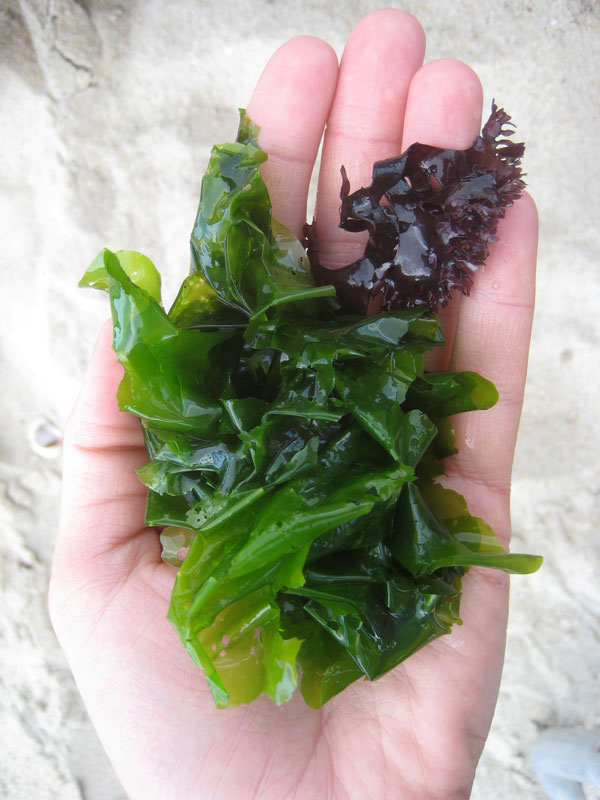
My parents shot me quizzical looks last summer when I announced my plan to gather seaweed in Long Island Sound, off the Connecticut coast. Not only would I collect, but also dry the seaweed at their house so I could take it back to Colorado with me for cooking experiments. I experienced similar incredulity from Connecticut’s DEP Inland Fisheries Division when I asked for a permit to harvest seaweed for personal consumption.
And yet, seaweed collection is a longstanding tradition along swaths of North America’s West Coast, where local indigenous peoples made—and continue to make—seaweeds a part of their diets.
In British Columbia, for example, the Kwakwaka’wakw and Haida packed layers of partially dried and fermented red laver (Porphyra abbottae syn. P. perforata) into tall cedar boxes along with boughs of Western red cedar and then left them for a month, weighted down with rocks, before unpacking and repeating the process several times to make seaweed cakes (Turner, 1997 ed.). They would later tear or chop these cakes into small pieces, soak and boil the seaweed and serve it with the rendered grease of euchalon—a small, greasy fish—along with boiled dog salmon or clams.
The middle and northern coastal First Peoples of the same region gathered herring spawn-covered blades of giant kelp—the brown algae Macrocystis integrifolia—and dried them out to later reconstitute, boil, and eat with euchalon grease or cut into strips for chewy snacks that children could carry to school with them (Turner, 1997 ed.). To protect herring populations, however, this practice is now illegal in most states without a special permit (Hahn, 2010).
Fortunately there are many spawn-free seaweeds—or sea vegetables—in coastal waters around the world, almost all of which are edible, conditions permitting.
In northwest Washington, Arcadian Abe writes of collecting rockweed bladders (Fucus gardneri), nori (Porphyra sp.), sea lettuce (Ulva sp.), sugar wrack (Saccharina latissima), bull kelp (Nereocystis luetkeana), and sea cabbage (Hedophllum sessile). In Oregon, wild food expert Dr. John Kallas hosts an annual Native Shores Wild Food Rendezvous. In addition to collecting and processing “sea vegetables,” participants learn about shellfish and coastal edible wild plants, including information on permitting.
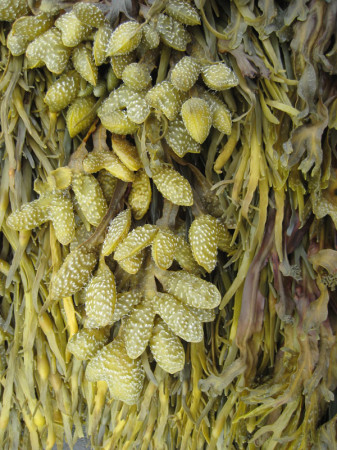
Seaweed collecting licenses are required in several western states, often through local fish and game or marine resource departments, with regulations pertaining to where, when, quantities permitted, and closures or areas with health risks.
In Connecticut, however, it was another story—I could collect seaweed for personal use without a permit, but it was not going to be easy to find out where it was best to do so. “We don’t test for seaweed,” the gentleman at the DEP told me. “We could not make such a recommendation.”
No Seaweed from the Rip
I looked for seaweed first while out fishing with my dad. “You probably want to avoid the rip current,” he said, maneuvering the boat away from a 20-foot-wide swath of brown and debris that stretched in a wavy line across the water in both directions. No, I did not want to collect seaweed from that mess.
“Seaweed can get contaminated by toxic chemicals, viruses, or bacteria,” Jennifer Hahn writes in Pacific Feast (2010). “Avoid sewage outfall areas, hazardous waste sites, logging facilities, manufacturing areas, industrial sites, and areas closed to shellfishing for fecal contamination.”
Additional concerns apply to warm tropical seas, where seaweed can transmit cholera if it is contaminated by the feces of infected humans, Dr. Ryan Drum writes. He writes, too, of deaths caused by eating seaweed that came into contact with the neurotoxin palytoxin, produced by a brown algae symbiotic with Palythoa sea anemones, which do not yet occur in northern waters.
“During the winter months, bacteria is not a problem in kelp aquaculture areas,” explained Dr. Charles Yarish, professor of ecology and evolutionary biology at the University of Connecticut, who studies and promotes seaweed farming in the northeastern United States where there is a distinct, cold, winter season. In terms of algal blooms affecting seaweed aquaculture projects, he notes: “I think the decision to harvest requires the due diligence of coastal managers to make sure there are no cysts attached to any of the harvested seaweed. Tests need to be performed for each situation.”
Hahn (2010) points out that seaweeds are not affected by paralytic shellfish poisoning (PSP) or domoic acid, but that they are magnets for radioactive isotopes, arsenic, and heavy metals like mercury, lead, and cadmium. For seaweed foragers, wild coastlines or clean, circulating waters are best, she writes.
I have walked beaches with so much seaweed washed ashore, and mixed with so much questionable garbage that a person would dare not step knee or calf-deep into it, let alone eat any of it. Especially when the seaweed has sat for days or weeks and turned potent.
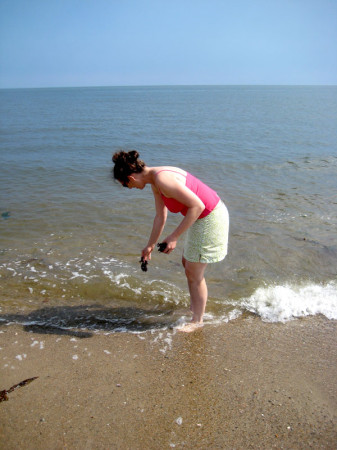
In fact, sea lettuces of the genus Ulva can proliferate in great abundance in waters polluted with sewage or other contaminants like runoff from agricultural lands and over-fertilized lawns. The mats can block off sunlight, causing die-offs of fish and other creatures. When these mats wash ashore and begin to decay, they produce toxic hydrogen sulfide, methane, and other gases (https://seaweedindustry.com).
“If you smell rotten eggs as you approach the seashore, head inland immediately,” Wildman Steve Brill notes in his iPhone app, Wild Edibles Plus, citing the 2009 death of a French lorry driver who carted several truckloads of sea lettuce from a contaminated beach in Brittany before dying at the wheel of his vehicle.
China has been experiencing similar “green tides” of sea lettuce since 2008 due to excess nutrients in its coastal waters, Yarish said.
Three Sea Weeds to Start
We didn’t see much free-floating seaweed that day on the boat, so that’s when I set my sights on the beach.
Seaweeds, a loose term that refers to macroscopic marine algae of many genera, can be collected where they grow—as commercial harvesters, divers, and those fortunate to live by tidal inlets shallow enough at low tide to allow it are wont to do. In that case there are sustainability guidelines to adhere to—like cutting seaweed fronds above the holdfast, the root-like structure that attaches to the substrate below, leaving portions of the frond so the plant can photosynthesize, and spacing out the harvest so as not to denude a particular spot. On that front, Maine Seaweed Council [PDF] has species-specific sustainability guidelines for collecting seaweed in situ in the northeastern United States.
Some foraging authors write that seaweed can be collected where it washes up on the beach. In Hunt, Gather, Cook (2011), Hank Shaw recommends gathering kelp off the sand at low tide, or combing the beach after strong full-moon tides.
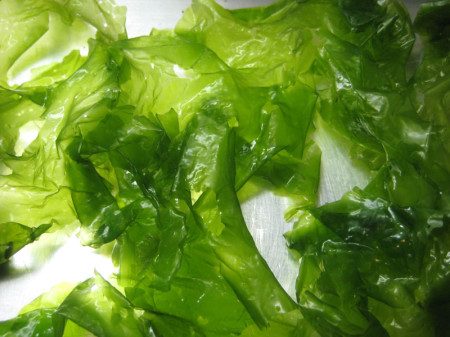
Although I later heard a different opinion on that topic from Dr. Yarish, who prefers seaweed cut where it grows, I decided to collect my sea vegetables from the Old Lyme beach I’ve been frequenting for years with my family. Many authors note that seaweed spoils quickly, so I took Shaw’s suggestion and ported large glass mason jars to the beach with me, then filled them with seawater to protect my seaweed samples.
I took samples of three easily recognized seaweeds. First was sea lettuce. This distinctive seaweed is bright and translucent green, making it look like a sheet of cellophane, often with holes it.
There is a lot of confusion about sea lettuce, Yarish noted. Many people assume that all similar-looking sea lettuces are Ulva lactuca, when in fact there are numerous species that look similar and have similar edibility characteristics but are different on a cellular level. In Long Island Sound, for example, he said the most common species is Ulva rigida, which grows primarily in late spring, summer, and fall. But there is also an invasive Ulva from Asia that has more holes in it than the native species. To differentiate them, he said they need to be examined under a microscope.

The genus Monostroma, similar in appearance to sea lettuces, can be used similarly.
I did not take any icky-looking, discolored, dried out, or sand-clogged pieces of sea lettuce that had washed ashore. Instead I traipsed thigh-deep in the waves, gathering just the healthiest looking specimens floating in the surf.
I also gathered strips of sugar kelp or sugarwrack—the brown algae Saccharina latissima, formerly classified as Laminaria saccharina. These long blades of brown algae have flat midribs and somewhat ruffled edges, and can grow 10 feet in length. S. latissima grows anchored to rocks and other substrates by long, cylindrical stalks. It is the most common species of seaweed in Connecticut kelp beds, and the largest seaweed in Long Island Sound, according to Connecticut Wildlife by Geoffrey A. Hammerson (2004).
Sugar kelp was a common sight for me as a child growing up on the Connecticut shoreline. My cousin once wrapped me head to toe in it to make a Jabba the Hut costume for a childhood game of Return of the Jedi. Now, this landlocked Coloradan need only take a whiff of dried sugar kelp to be transported back to Long Island Sound, to running barefoot over pebbly, seaweed-strewn beaches, or crabbing from the rocks using mussels and found string.
Saccharina latissima is one of many species of brown algae called kelp. The related S. japonica, commonly called “kombu,” is used in many Asian dishes including dashi—a soup base made by boiling squares of kombu, discarding the seaweed, and soaking bonito fish flakes in the broth before discarding those too. I made my first dashi this way, adding miso, dried and chopped wild green onion (Allium sp.), and a very unique dried mushroom—the purple finger fungus Clavaria purpurea—of which I gathered a small sample in the Colorado high country last fall. That made a pretty cool soup, if I do say so myself.
The last seaweed I sampled was the frilly, purple Irish moss (Chondrus crispus), also known as carrageen moss. This seaweed is rubbery like cartilage when wet, but dries to a hard crisp. Free-floating pieces of Irish moss look a little like neurons, as a friend on FB recently commented. But when it grows in abundance, carpeting tide pools, it bears a resemblance to dry-land moss. Irish moss pieces can also be bleached by the sun, rendering them white. Euell Gibbons writes in his 1964 seaside manifesto, Stalking the Blue-Eyed Scallop, “the Irish moss purchased by housewives in grocery stores for making jellied fruit desserts and blancmange is usually a creamy white color,” having been bleached by collectors prior to sale.
Irish moss is different than other seaweeds. It is valued as a thickener, harvested for the polysaccharide carrageenan, which is used in the food, cosmetic, and pharmaceutical industries. Products using Irish moss include ice cream, air fresheners, and cough syrups (www.seaweedindustry.com).
Irish moss is also used to make the traditional Irish pudding, blancmange. Gibbons (1964) recommends washing Irish moss pieces thoroughly to prevent a fishy taste, then packing as much of the seaweed as possible into 1 cup, tying that in a cheesecloth bag, and putting the bag with 2 quarts of milk in the top of a double boiler for about 30 minutes, stirring the mix and squeezing the cheesecloth to extract as much of the gelatinous material as possible. Then, he writes, discard the spent seaweed; add 3/4 cup sugar and a pinch of salt; allow the milk to partially cool; add fruit or other flavoring; pour it into a mold; and chill in the refrigerator until it sets. (My first attempt at this was unsuccessful, but since then I gathered more Irish moss and plan to try again.)
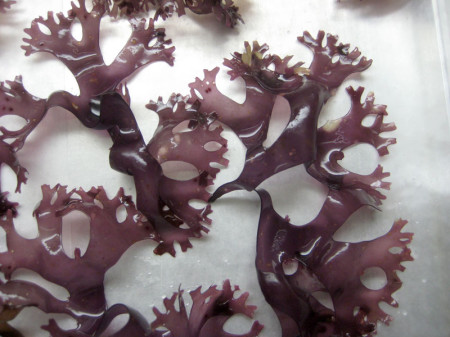
The same thickener, Gibbons writes, works well in other puddings, soups, sauces, and gravies. In Stalking the Blue-Eyed Scallop, he makes a “‘civilized’ aspic salad” with Irish moss and vegetable juices poured into a mold and allowed to set.
Other seaweeds can be used in a similar fashion as thickeners. Jennifer Hahn has a wonderful story of making a dessert with leftover frozen Turkish towel blades (Chondracanthus syn. Gigartina spp.) by simmering the seaweed slush in half-and-half, straining out the blades, and then melting in chocolate chips for a rich and velvety chocolate cream, which she poured over frozen raspberries and served as “Chocolate Ocean Pudding” to her astonished dinner guests.
Lotta Seaweed in the Sea
I started with only three species of wildcrafted seaweeds, but there are many edible species used by coastal cultures around the world. In Japanese cookery, for example, nori refers to red seaweeds of the genus Porphyra. Japan’s wakame is Undaria pinatifida, but species of Alaria on the east and west coasts of the U.S. are said to work well in its stead.
In addition to Irish moss (Chondrus crispus), the red algae dulse (Palmaria palmata) is popular in Ireland and Scotland, where it is said to pair well, dried and chewed as a snack, with dark ales and stouts, according to Victoria Abbott Riccardi in Viv Mag (2012). Unlike other seaweeds, dulse is soft and pliable when dried, and it was once hawked at Boston railway stations and street corners by Irish immigrants (Gibbons, 1964).
Other edible seaweeds to be foraged off the coast of Maine include bladderwrack (Fucus spp.), rockweed or knotted wrack (Ascophyllum nodosum), fingered kelp (Saccharina digitata), oarweed kelp (Saccharina longicruris), winged kelp (Alaria esculenta), and nori (Porphyra sp.), to name a few.
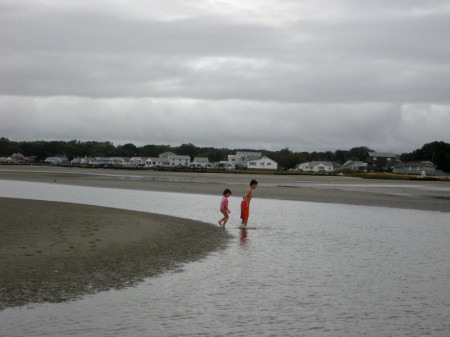
Almost All Seaweeds Are Edible
Many authors write that all seaweeds are edible, or at least that no seaweeds are poisonous—a comforting statement to would-be foragers uncertain of their identifications.
And yet, Hahn (2010) writes that “one wrong sea veggie can ruin your day.” That seaweed is of the genus Desmarestia, a brown algae also known as “acid kelp” or “color changer.” It contains sulfuric acid and should not be eaten. There are two forms of this seaweed—“a hairy foxtail or a flat ribbon with branching toothed blades and a vein pattern,” she notes. If you nibble a seaweed you’re uncertain about and it has a bitter or sour taste, it could be a Desmarestia.
The sulphuric acid in some, but not all Desmarestias, is an anti-herbivore compound the seaweed produces to protect itself against ocean critters, Yarish explained. Similarly, rockweeds of the generas Fucus and Ascophyllum produce phenols that are anti-herbivore compounds. “Rockweeds make a good miso soup base,” said Yarish, who prefers Ascophyllum over Fucus for the purpose. But because of the anti-herbivore compounds, he says he “pays attention” and limits his rockweed consumption.
It thus seems safest to say that “most” seaweeds are edible, and a good practice to stick to known edible species. Attending a regional seaweed foray, if available, is a good idea for first-time seaweed foragers.
Seaweeds & Fallout
Seaweeds are high in iodine, and a few folks are very sensitive to iodine, with overuse leading to nervousness, heart palpitations, sleeplessness, irritability and even iodine-induced goiter, writes Drum, a herbal teacher who has a BSc in chemical technology and a PhD in botany (phycology—the study of algae). Individuals exhibiting such symptoms should examine their iodine consumption, not only from seaweeds, but also dairy and baked goods, he writes in an in-depth essay about the medicinal uses of seaweed.
And yet, Drum explains that the naturally occurring Iodine 127, found in larger quantities in seaweeds than any plant or animal, is essential to human life. “The iodine story as related to human health took an interesting turn when Uranium was used to cause nuclear fission: one of the decay products of nuclear explosions is Iodine 131,” Drum writes. “Iodine 131 is hazardous because our bodies will happily take it in if we need iodine,” but this isotope is an inducer of thyroid cancer, which has increased significantly worldwide since the Chernobyl disaster in 1986. However, if we have sufficient amounts of the natural isotope Iodine 127, our bodies will not take in Iodine 131—a protection he says can be achieved by eating 3-10 grams of seaweed daily (or iodized salt, for that matter).
By way of example, he recounts how, immediately following the Chernobyl disaster, Polish authorities encouraged citizens to take iodine solutions, potassium, sodium iodide tablets, and seaweed tablets and capsules. “Over the intervening 20 years, the Polish people treated with Iodine 127 have almost 1,000 times less thyroid disease than neighboring countries even further than Poland from the Chernobyl disaster site,” Drum points out.
The Japan-based nonprofit, Childresearch.net, and other groups are discussing the benefits of seaweed consumption in the wake of the Fukushima nuclear accident.
That said, seaweeds do bioaccumulate iodine, Drum notes, so Iodine 131 might be expected to occur—in which case he writes that we can let the suspected isotope decay prior to consumption. “A precautionary safe practice is to let all fresh/dried seafood age 60 days prior to ingestion. This is easiest with smoked and frozen animal seafoods,” he states in a 2013 follow-up piece, “Radiation Protection Using Seaweeds.”
In addition to Iodine 131, nuclear power plants release the radioactive isotopes Cesium 137 and Strontium 90, however, and seaweeds do not appear to protect against these. Drum writes that in the West, members of the Seaweed Stewardship Alliance—a group of commercial hand-harvesters of dietary seaweeds in California, Oregon, and Washington—are in contact with health and environmental agencies monitoring the levels of Fukushima-sourced radioisotopes.
Kelp Watch 2014 is sampling kelp forests from more than 30 locations on the California coastline to determine radiation levels and whether they pose a significant health risk to the food chain.
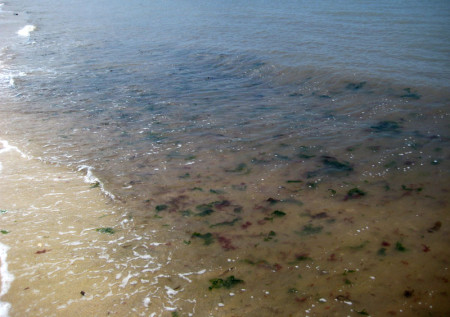
The big picture, however, is that clean seaweeds offer myriad health benefits. “Sea vegetables are excellent sources of most minerals, especially: potassium, sodium, calcium, magnesium, sulfur, nitrogen, iron, zinc, boron, copper, manganese, chromium, selenium, bromine, vanadium, nickel; often better sources than meat, whole milk, or eggs and usually better than any land plants,” writes Drum, who is also a purveyor of wild-crafted herbs and sea vegetables through his company, Island Herbs.
Hahn (2010) goes so far as to call seaweed “the most nutritious vegetable on earth.” Others call it “the new kale” and tout seaweed as a superfood.
Just Eat Seaweed
It felt like I’d gathered a fair bit of seaweed on the Connecticut coastline that day, but it turns out once it dries it shrinks down quite small. I rinsed the samples in fresh water prior to laying them out to dry all over my parents’ Connecticut home. (I later read in Hahn’s book that some seaweed is better not rinsed in fresh water). I dried the Irish moss and sea lettuce whole, but cut the sugar kelp into 2-inch squares. Much to my parents’ chagrin, the house smelled like the seashore, especially after I stuck a few batches in the oven after dinner, the heat off but the oven still warm, to hasten the drying process. When all was said and done, I managed to fill three small mason jars with dried seaweed.
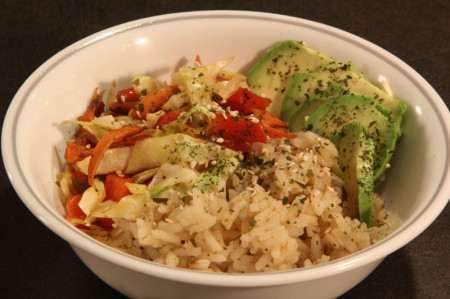
Later, I ground the sea lettuce and most of the sugar kelp down into powders, and then my take became utterly laughable—for neither came close to filling a spice jar! But you have to start somewhere, and I prefer to play with wild ingredients in small quantities to figure out what I like and how much I think I’ll need before I collect in larger quantities. At least, that is what I told myself when I ran out of sea lettuce trying to get my sesame seed and sea veggie candies to set.
While some authors write that seaweeds can be gathered year-round, Yarish said each sea veggie has its season. In any case, it’s worth a look if you live by the seashore. Seaweed is also easily foraged from the grocery store or specialty vendors. As one commenter pointed out on my FB page, there is less chance of wasting a wild batch if you learn to cook with it first.
Unlike many other wild ingredients, there is a wealth of information available on what to make with the various seaweeds, both fresh and dry. Armed with miso, mirin, rice vinegar, and bonito fish flakes, I drooled for days over the Japanese recipes at Just One Cookbook: Easy Japanese Recipes, before endeavoring to make my first kombu-soaked dashi broth, which I used in the aforementioned miso soup.
Jennifer Hahn’s book, Pacific Feast, is a veritable ocean of ideas for West Coast seaweed cookery, and Hank Shaw (2011) likes to add dried kelp to broths used in seafood pastas, risottos, and soups for a briny, savory umami flavor. Yarish recommended Irish Seaweed Kitchen by Prannie Rhatigan. “She’s an excellent cook and also a public health official,” he said. “It’s a nice, comprehensive guide to eating healthy and good seaweeds.”
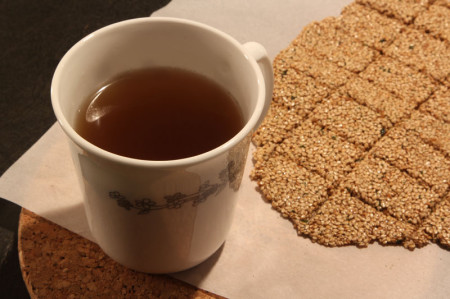
I managed to pull off some yummy rice dishes—an hors d’oeuvre of rice topped with sliced cabbage and avocado and seasoned with a sweet sea lettuce dressing, followed by a main course of steamed rice seasoned with sugar kelp and rice vinegar topped with kombu-accented veggie stir fry. “It’s like we’re having sushi at home. It’s delicious!” Gregg exclaimed about the first plate, tossing me a bewildered glance as if he couldn’t believe it were humanly possible I could come up with such a thing. “I’m having a great time,” he said.
The biggest hit in our house, however, turned out to be an experimental batch of toasted, savory-sweet sesame seed candies flavored with brown sugar, mirin, soy sauce, and sea lettuce. “This is the best candy I’ve ever had,” Gregg said, stealing more bites than I’d planned to serve him.
The next things on my list to try, next I visit the seashore, are Mac Smith’s bladderwrack cheese puffs (Hahn, 2010), and some fresh, thin-sliced, rice vinegar-marinated seaweed salads with sesame seeds on top.
I swear, I am in love.

I love seaweed in Japanese dishes and your post reads fantastic. Unfortunately we don’t have sea access in Austria 😉
Cenaturimus
Am wondering what is the best time to collect sea lettuce in the water close to the shoreline? High tide, low tide or going out or going in tide? What’s your experience?
Hello! I live on the CT coast and this was such an exciting article to read 🙂 You mentioned this in your article, but I was wondering if I could know further your thoughts on the pollution in the long island sound? I’ve heard it’s not clean water, but I’m also sure it depends on where you are. I would love to go harvest some of this!
Hi! So sorry for the delay responding. I don’t really have updated thoughts on seaweeding in Long Island Sound at this point. That post was about all I could find at the time. I do know that there are small-scale commercial foraging operations out of Maine. That might be a better choice for seaweed foraging. Also if you can dive and cut it off from the substrate it would be fresher. All that said, I do go clamming in Rhode Island and one spot in CT when I’m home visiting my parents. I would think if the shellfish beds are open (sometimes there are periodic closures for algal blooms or presumably waste overflow) then at least they have been determined safe for shellfish for that location and time period, so that might be a good place to target your efforts.
My apologies, I meant to reply to your comment ages ago. It has been a long time since I foraged for sea lettuce but I think I would go for tide pools where the sea lettuce is still growing attached to the substrate, because it would be freshest. Then cut it at low tide with a knife above the holdfast so it can regrow. And of course identifying a location first that does not have wastewater outflow nearby. I think clam beds that are open (since they are monitored for algal blooms and presumably waste overflow) might be a good strategy for finding a clean location.
Great article! I plan on harvesting seaweed for composting. I’m hesitant to eat what I harvest locally in southwestern CT. I’m more comfortable foraging ground species!
Have you ever seen wild arugula on the Connecticut shoreline? I know where there is some next to a beach in Guilford. I can send photos. (Taken in season)
How cool! No, I have not seen it growing wild before.